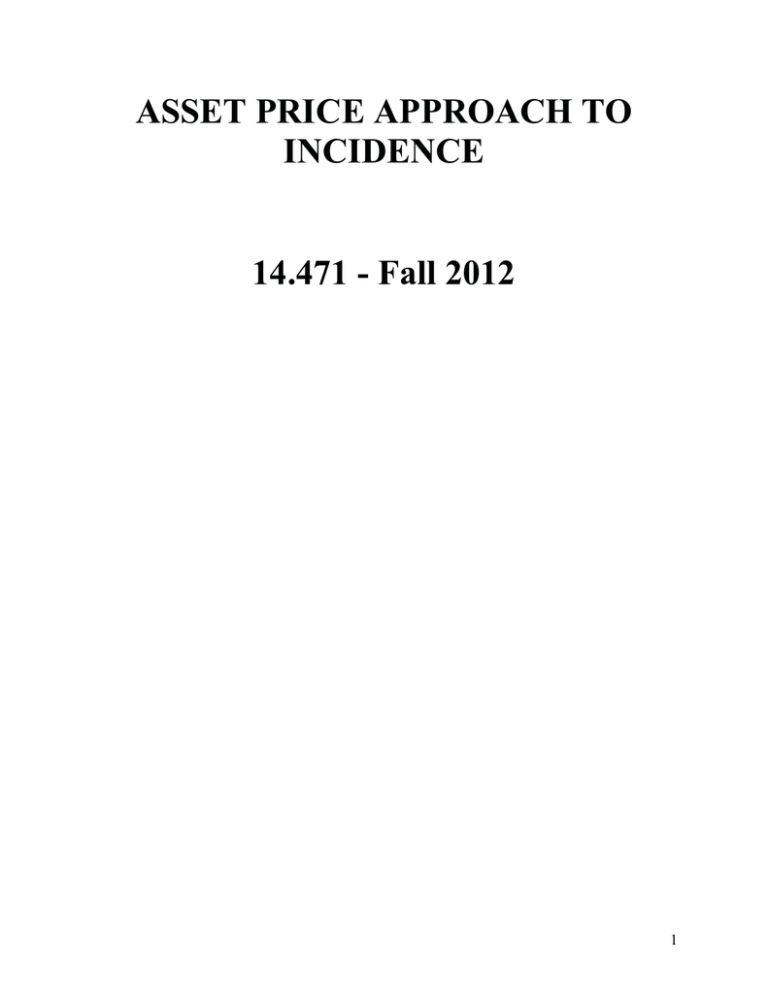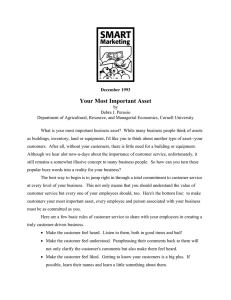Document 13439989
advertisement

ASSET PRICE APPROACH TO INCIDENCE 14.471 - Fall 2012 1
Many taxes are levied on durable assets (houses, physical
capital such as buildings and equipment, patents, natural
resource stocks)
These are traded assets with prices - changes in current
and future taxes can affect these prices.
Key component of incidence: price changes for existing
asset owners. How much do prices change? By the
change in the present discounted value of future tax
payments associated with that asset.
Best illustrations are in markets with long-lived assets:
corporate capital, land, housing are examples. Focus on
owner-occupied homes following Poterba QJE 1984.
Equilibrium condition in durable asset market:
Value of asset services per unit: R(H)
R'(H) < 0 reflects diminishing value of housing capital
R(H) must equal the investor cost of holding the asset for
one period. This cost includes the depreciation of the
asset (exponential at rate 8 per period) and the opportunity
cost of funds. We denote this as (1-1)r: the after-tax
interest rate. There might also be a risk premium, but
assume not for now.
2
The investor cost also includes any capital gain or loss to
holding the asset. A capital gain reduces the investor cost
of holding the asset; a capital loss increases it.
qH, t = asset price at the start of period t
qH ,t +1 - qH ,t = capital gain or loss during period t
Equilibrium Condition:
(1) R (H t ) = qH ,t (r (1 - ' ) + 8 ) - (qH ,t +1 - qH ,t ) .
Consider a tax on each house that takes the form of a
required payment Tt in period t. Because houses are longlived assets, even taxes that will not be levied until future
years can depress prices today. In each period when the
tax is levied, the equilibrium condition becomes
(2)
R(H t ) - Tt = q H , t (1 + r (1 - ' ) + 8 ) - q H , t +1 .
Note that qH ,t+1 is not generally know at time period t.
Assume perfect foresight; one could also embed this
analysis in a stochastic model of price determination.
To find the qH from (2), solve forward by rewriting (2) as:
(3)
qH ,t
R(H t ) - Tt + qH ,t +1
=
1 + r (1 - ' ) + 8
.
3
Solving recursively by substituting for qH ,t +1 yields, after
multiple substitutions,
S
(4)
qH ,t = ±
i=0
qH ,t + S
R(H t +i ) - Tt +i
+
(1 + r (1 - ') + 8)i+1 (1 + r (1 - ') + 8)S +1
.
We impose a transversality condition to rule out an
“exploding” asset price:
q
(5)
lim
S�
H ,t + S
(1 + r (1 - ') + 8)S + 1
=0
.
With this condition we can see how a stream of tax
liabilities {Tt} will affect the price of houses:
(6)
qH ,t = ±
i =0
R(H t +i )
i+1
(1 + r (1 - ') + 8)
T
± (1 + r (1 -t'+i) + 8) i+1 .
i =0
The second term is the present discounted value of current
and future tax payments.
If the stock of housing is fixed, so Ht+i = Ht for all i, then
from (6) we can determine dqH,t/dTt+i. When the housing
stock is endogenous, however, changes in future tax
policies will also affect current and future investment,
hence {Ht}. In general the effect of changing {Ht} will
offset the effect of taxes on house prices. When taxes
rise, thereby depressing prices, housing construction will
4
decline. That will raise the rental value of a unit of
housing services, thereby helping to raise prices.
Need to model supply function for new construction:
(7)
I t = \ (qH ,t )
where I t denotes gross construction of new housing. The
net change in the housing stock is given by
(8)
H t +1 - H t = \ (qH ,t ) - 8H t .
The corresponding equation for the evolution of house
prices from (2) is
(9)
qH ,t +1 - qH , t = (r (1 - ' ) + 8 )qH ,t - R(H t ) + Tt .
Equations (8) and (9) define a two-equation system of
difference equations in two variables: (q H ,H ) . To analyze
how the value of q H ,t responds to a shock to {Tt}, we
analyze the stability properties of this system of
difference equations using phase diagram methods.
The figure below shows the loci on which qH and H are
respectively constant. The steady state is defined by:
(10) \ (q H ) = 8H and (r (1- ' ) + 8 )q H = R(H ) - T .
5
When the system is out of equilibrium, for example when
a tax shock moves the (dqH/dt) curve, there is a unique
stable path that leads to the equilibrium point; conditional
on a value of H, there is only one value of qH that will
result in the system evolving back to the equilibrium.
One can link this diagram to the basic partial equilibrium
incidence diagram we have used before. Note that even
when the dH/dt = 0 locus is horizontal, so there is a fixed
long-run supply price of housing, a leftward shift in the
dqH/dt= 0 locus induced for example by a new tax on
housing would create a transitory decline in house prices
that would burden existing house owners.
6
To illustrate how this framework can be used to evaluate
changes to housing tax policy, consider a plausible
measure of the user cost of owner-occupied housing in the
current tax law:
(11) c = [1–1y]*(ArM+(1- A)rAlt+B) + m + (1-1ded)�1prop – 1e
where 1y is the marginal income tax rate for mortgage
interest and property tax deductions as well as investment
income, rM is the mortgage interest rate, A is the loan-to­
value ratio on the house (fraction of house financed with
mortgage), rAlt is the return on the alternative assets that
the household might invest in if not using equity for a
house, B denotes the pre-tax housing risk premium, m is
the combined cost of depreciation and maintenance, 1prop
is the property tax rate, and 1e is the expected rate of
nominal house price appreciation. Plausible parameter
values for 2012 might be: 1y = .25, rM = rAlt = .04, A =
0.75, B = m = .02, 1prop = .015, 1e = .02. This implies c =
0.05625.
What if we eliminate the federal income tax deduction for
the property tax? Now c' = 0.06. This is an increase of
6.7 percent; with fixed H and a price elasticity of demand
of -1, house prices would drop by 6.7 percent. Calibrated
rational expectations model suggests -3.7 percent.
7
Empirical work to be done in asset price models:
(i) estimate elasticity of demand for the durable asset (this
is calibrating R(H));
(ii) estimate supply curve \(qH)
(iii) estimate how other endogenous variables (loan-to­
value ratio, level of property taxes) might respond to
changes in federal tax rules.
Estimates of User Costs of Owner-Occupied Housing in
2003 (from Poterba & Sinai, Natl Tax Jnl 2011; average
= 0.059)
Age of Head
25-34
35-49
50-64
65+
All
<40K
0.065
0.065
0.066
0.070
0.068
40-75K
0.060
0.059
0.059
0.059
0.059
75-125K
0.053
0.054
0.055
0.056
0.054
125­
0.048
0.049
0.050
0.053
0.050
250+
0.045
0.046
0.046
0.049
0.046
8
Applications of Asset Price Incidence Analysis:
Proposition 13 in California: Property Tax Reform
(K. Rosen, JPE 1982)
Community
Berkeley
Pleasanton
Novato
Menlo Park
Atherton
Property Tax Rate
FY1978
13.75
12.83
10.62
8.64
8.81
Property Tax Rate
FY1979
5.04
5.60
4.81
4.09
4.14
�House Price = 7.28�Tax Saving + Home Attributes�p
(2.45)
Impact of Corporate Tax Reform
(D. Cutler AER 1988)
Tax Reform Act of 1986 (TRA86) Generates Differential
Benefits for Different Firms
Event Study Methodology: Return on Security i at time t:
Rit = Ui + pi*RM,t + tit (CAPM - could do multi-factor)
ADD: Variable capturing news of policy change. Let It
denote indicator variable for days on which the
9
probability of tax reform rises. Let %Equip denote share
of firm's capital stock that is equipment. Prediction: firms
with more equipment (ITC was eliminated) should
experience higher returns b/c their competition will have
to pay more for equipment.
Estimate:
Rit = Ui + pi*RM,t + A�����P�i*It + t it
A measures change in value -- but calibration requires an
estimate of change in PROBABILITY of law passage
over all It.
One Day Window
10-Day Window
30-Day Window
A without industry
effects
0.018
(0.012)
0.083
(0.025)
0.064
(0.043)
A with industry
effects
0.000
(.015)
0.035
(0.031)
0.024
(0.051)
Predicted effect from simulation models: 0.07. Why are
coefficients so much smaller?
10
MIT OpenCourseWare
http://ocw.mit.edu
14.471 Public Economics I
Fall 2012
For information about citing these materials or our Terms of Use, visit: http://ocw.mit.edu/terms.




